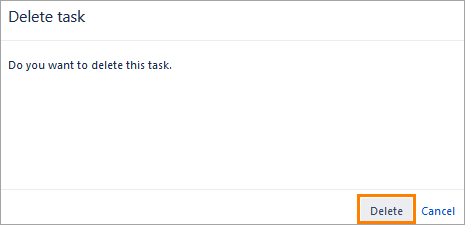Creating and Using Test Automation Tasks
You can import test results from various test automation frameworks into Zephyr Squad test cycles, which ensures complete visibility and traceability into your automated test process.
How this works
To import automation results, you need to configure test automation tasks in Zephyr Squad that will upload and parse an XML test results file. Zephyr will create test cases and executions based on the information in the file and associate them with the selected test cycle and release version.
The procedure consists of two steps:
Create an automation task. Each automation task specifies the XML results file to be uploaded and the associated test cycle and release version. The XML results file can be attached directly to the automation task, or you can configure the ZBot software agent to upload a file from a specific location on a remote test agent.
Execute this automation task. This will parse the provided XML results file and add data to Zephyr Squad.
Note
You can configure Zephyr to automatically create defects for failed test executions. To learn how to do that, see Defect Configuration.
To create, view, and execute automation tasks, use the Test Automation page of your Jira project.
Create an automation task
Open your Jira project.
Click Test Automation in the project sidebar:
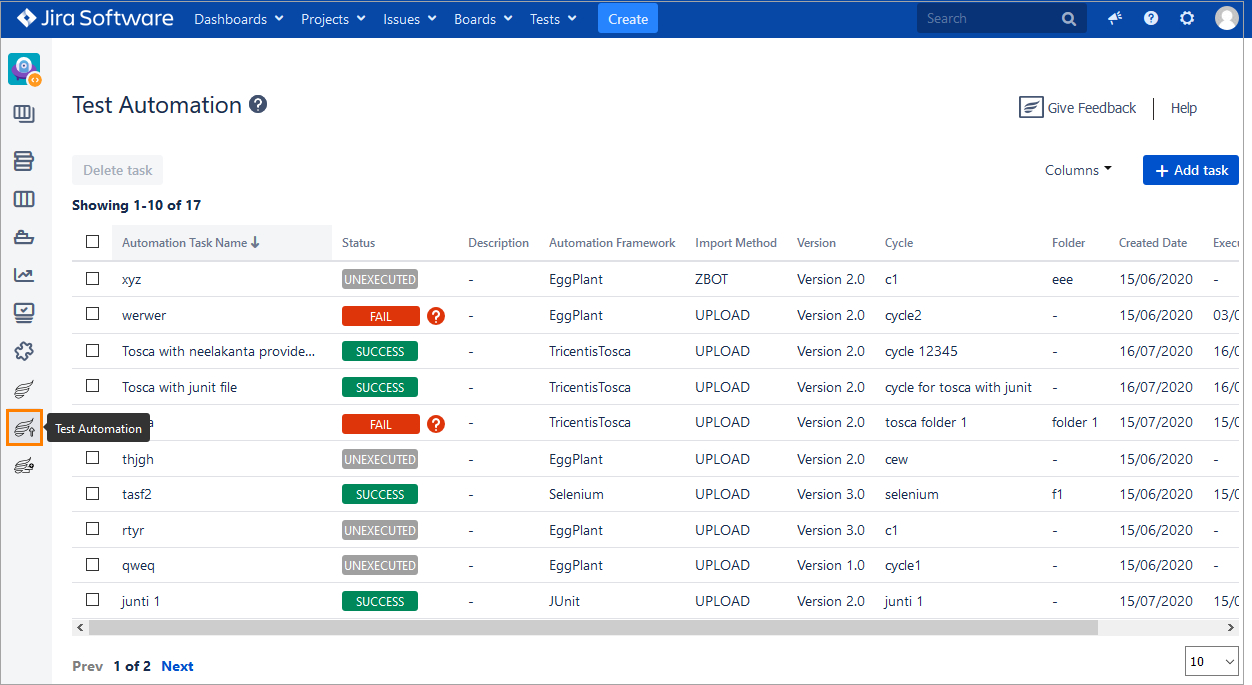
Click Add task in the top right corner.
Fill in the fields in the dialog. Some fields vary depending on the selected Import Method. If you select the Upload method, you will need to specify the results file to be uploaded. If you select ZBot, you will need to specify a software agent (ZBot) that will upload the file.
Note
Use ZBot if you don’t have direct access to the file containing test results. ZBot is a software agent that links Zephyr Squad with the automation framework being used. ZBot is configured once by a system administrator and is always up and running on the testing server. You can download ZBot by selecting Help > Download ZBot.
Note:
Sample configuration for the "Upload" import method:
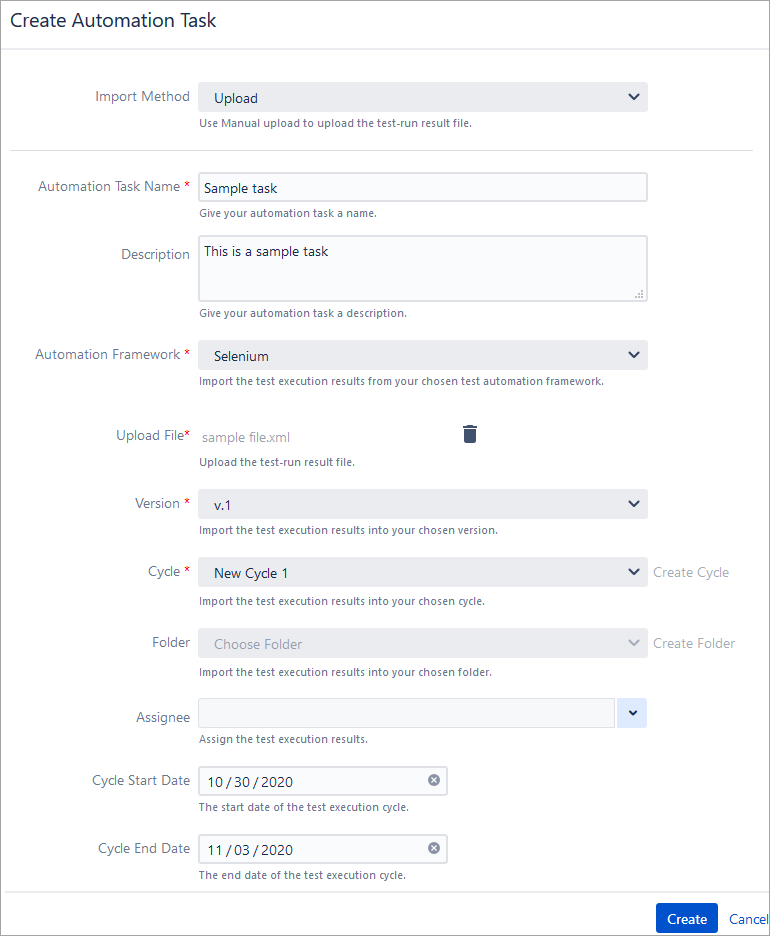
Sample configuration for the "ZBot" import method:
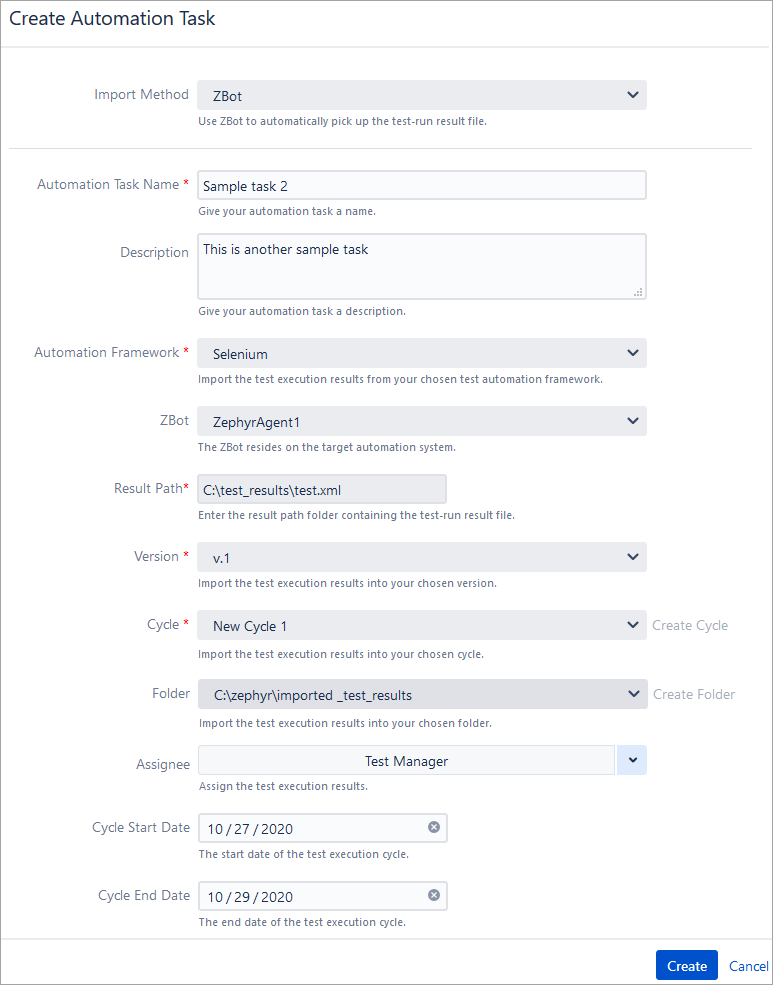
The dialog has the following fields:
Field name
Description
Import Method
Required. Possible values:
Upload– the default value. A single user can manually specify the results file to be uploaded from one of the supported test automation frameworks.
ZBot– use it if your team doesn’t have direct access to the results file on the testing server.
Automation Task Name
Required. The name of your automation task.
Description
Optional. Additional information about your automation task.
Automation Framework
Required. The test automation framework you will export test results from. Possible values:
Eggplant
JUnit
Selenium
SoapUI
TestNG
Tricentis Tosca
UFT
Cypress
Upload File
(used if the Import Method is Upload)
Required. Choose an XML results file you want to upload. For example, the JUnit XML report.
When this automation task is executed, Zephyr Squad will automatically create a test case and set the test execution status based on the information specified in this file.
Result Path
(used if the Import Method is ZBot)
Required. The path to the results file created by the automation framework. This path must be specified in the context of the server or computer where the test runner is located.
ZBot
(used if the Import Method is ZBot)
Required. Select a ZBot that will upload the file. ZBot must be previously installed on the same server or computer where the test runner is located. You can download ZBot by clicking Help > Download ZBot in the top right corner of the window:
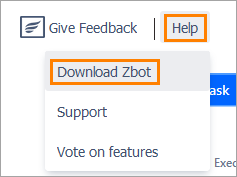
Version
Required. Select the version (release) to store the results of the automation task.
Cycle
Required. Select a test cycle to store the results of the automation task. To create a new cycle, click Create Cycle.
Folder
Optional. Select a folder to store the results of the automation task. To create a new folder, click Create Folder.
Assignee
Optional. Assign the test execution results to a specific user.
Cycle Start Date
and
Cycle End Date
Optional. The start and end dates of the test execution cycle.
Click Create:
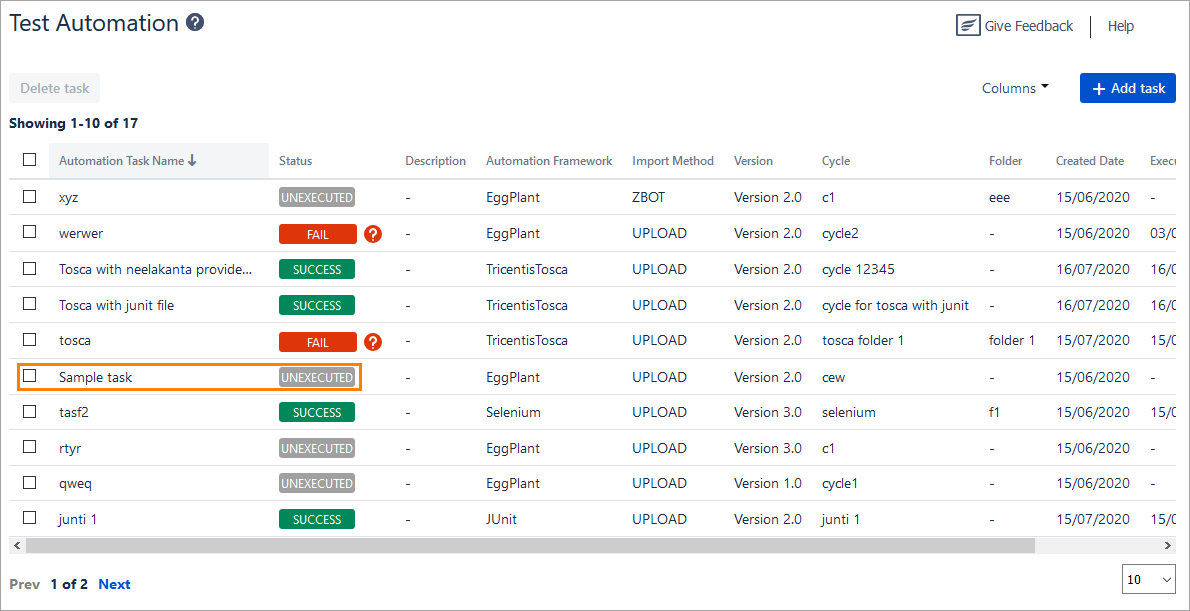
The created task appears in the list with the Unexecuted status. If you chose the Upload import method, the created task is disabled and grayed out until the results file is uploaded to Zephyr Squad. This may take some time depending on the file size.
Column descriptions
The Test Automation page lists all the tasks you have created. By default, the task details include the following:
Column | Description |
|---|---|
Automation Task Name | The name of the automation task. |
Status | The status of the automation task. Possible values:
|
Version | The release version selected by the user. |
Description | Additional information about the automation task. |
Automation Framework | The framework used for the automation task. |
Import Method | Specifies the upload mode. Possible values:
|
Cycle | The cycle that stores the results of the automation task. |
Folder | The folder that stores the results of the automation task within the test cycle. |
Action | Use the drop-down menu items to execute, edit, or delete the task.
|
Note
The Test Automation page saves the displayed columns and sort order per user per project.
To customize the columns, click Columns.
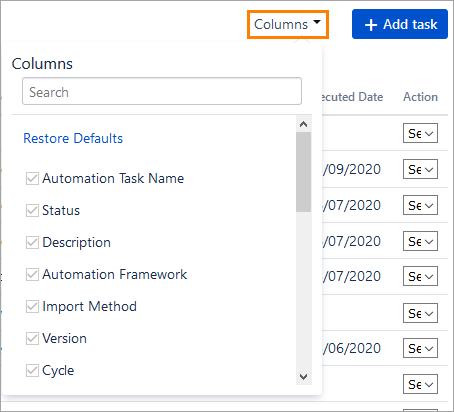
Execute an automation task
To execute an automation task, select Execute from the drop-down menu in the Action column:
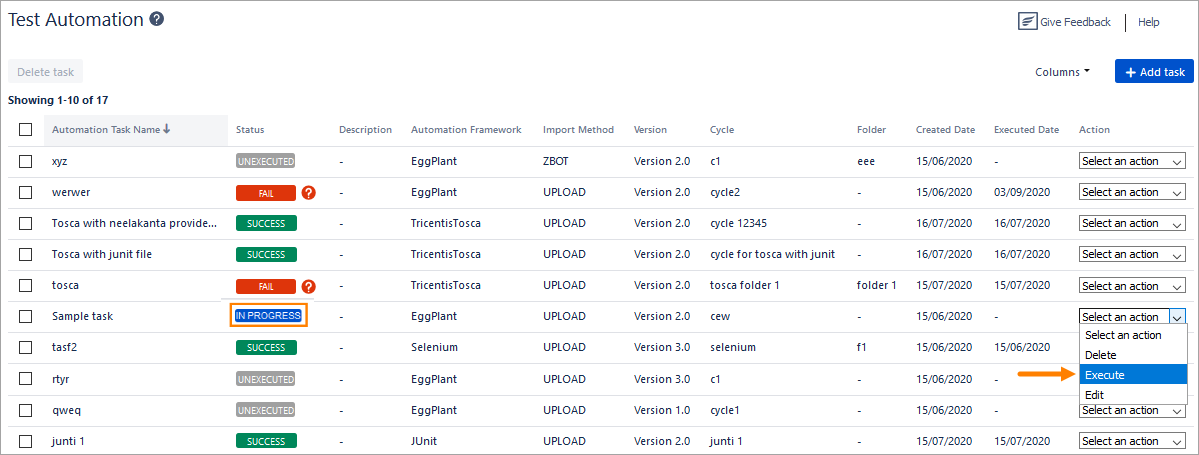
When you execute an automation task, the status of the task changes from Unexecuted to In Progress. It takes some time to execute the task. When the execution is completed, the task status changes to either Success or Fail. If a task fails, you will see a warning icon. Click it to learn what you need to do to execute the task successfully:

The status workflow of automation tasks is the following: Unexecuted -> In Progress -> Success/Fail.
When you execute an automation task, the test results are imported to Zephyr Squad from the specified location. Zephyr will create the specified cycle, folder, test cases, and will update the test execution status of the existing test cases to match the results from your automation task.
In the image above, you can see that we created one of the tasks for the selenium cycle. After executing the task, we can navigate to the Cycle Summary, select the selenium cycle and see that the automation task has imported the results, created test cases for the automation task, and then executed individual test cases as well to match the results of the imported automation task:
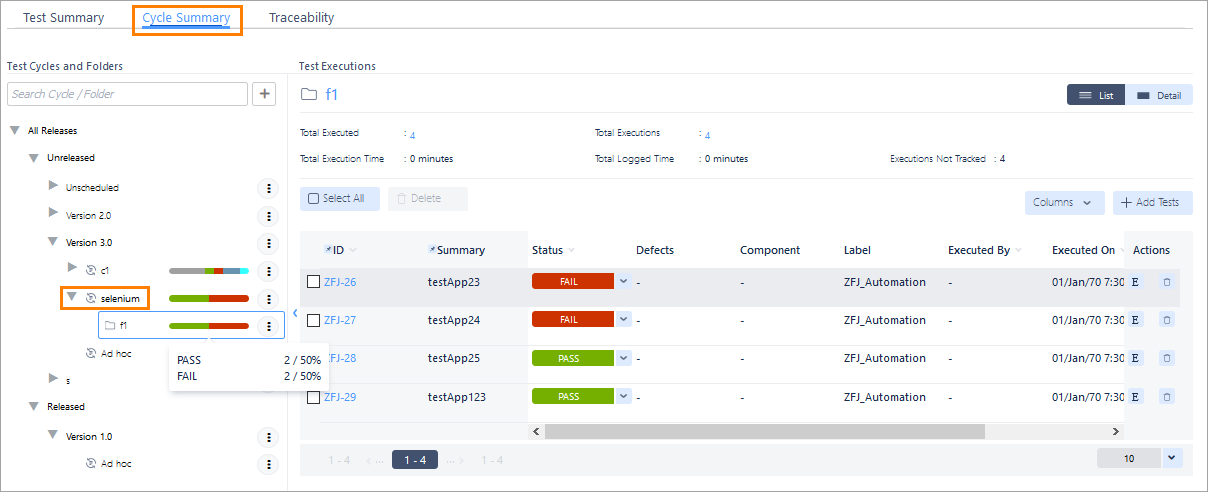
Delete an automation task
To delete one or several automation tasks, select the check boxes next to the tasks you want to delete and click Delete task:
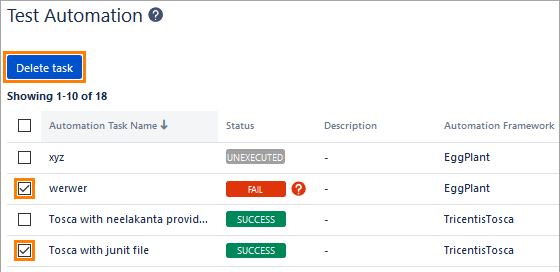
A dialog asking to confirm the action will appear. Click Delete to delete the selected tasks:
